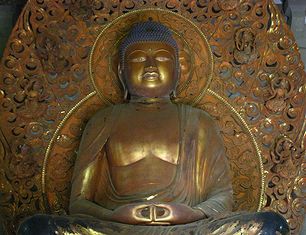
Content created: 2018-03-25
File last modified:

Background: The Heart Sutra (Xīn Jīng 心经) is the shortest of the Buddhist scriptures commonly used in China, and, as the Chinese name implies, it is understood as representing the heart or most central insight of Buddhism, and particularly of Chán 禅 (Zen) Buddhism.
 The original Sanskrit text, the Prajñāpāramitā Hṛdaya Sūtra (प्रज्ञापारमिताहृदयसूत्र), was translated into Chinese several times. The version most commonly used in modern times was rendered by the famous seventh-century priest Xuán Zàng 玄奘, remembered today because his trip to India to find Buddhist scriptures was immortalized in the famous novel Journey to the West, where he is accompanied by a picturesque and prodigious monkey. Most English editions of the Heart Sutra are retranslations from the Chinese.
The original Sanskrit text, the Prajñāpāramitā Hṛdaya Sūtra (प्रज्ञापारमिताहृदयसूत्र), was translated into Chinese several times. The version most commonly used in modern times was rendered by the famous seventh-century priest Xuán Zàng 玄奘, remembered today because his trip to India to find Buddhist scriptures was immortalized in the famous novel Journey to the West, where he is accompanied by a picturesque and prodigious monkey. Most English editions of the Heart Sutra are retranslations from the Chinese.
Like the Dàodé Jīng 道德经 of Daoism, the Heart Sutra's brevity, its obvious importance in China, and the attractive ambiguity of its phenomenal conciseness have made it one of the most frequently translated Chinese scriptures, although most translators, if one believes their introductions, are also inspired by the conviction that all prior translations have failed to get the meaning quite right. And nearly all translators feel the need to provide at least some expansion to make intelligible English. (More.)

This Translation: This translation is my own. It is not the most scholarly or best informed, but it may be freely used for educational purposes with no further permission. In making it I have been especially influenced by the sources listed at the bottom of the page.
This sūtra has produced some astonishingly tasteless Internet videos, although they do not necessarily remain available for long. Not one that I have heard sounds like a beautiful, traditional Chinese temple chant, but a range of "improved" musical performances can be found with a simple search.
Go to bilingual version.
Getting Started: Like many scriptures attributed directly to the Buddha, this one takes the form of an address to his talented disciple Śāriputra (Shèlìfú 舍利弗 or Shèlì Zǐ 舍利子).
Go to bilingual version.